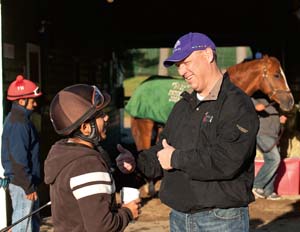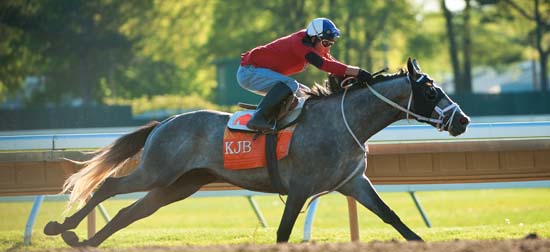 |
 |
| current issue |  |
past issues |  |
send a letter/news |  |
address update |  |
advertise |  |
about us |  |
alumni home |
Features
Animal MagnetismPage 3 of 4
For a relatively new, smaller stable, K&G has had a remarkable record so far. Out of more than 35,000 thoroughbreds registered each year, only 20 will eventually qualify, at 3, for the Kentucky Derby. In the past four years, K&G has had three horses in the Derby. (In contrast, Sheik Mo, who has spent hundreds of millions of dollars in his quest to win the Derby, has yet to own a horse that placed in the top three.) 2011 was a particularly good year for K&G, whose Pants on Fire drew attention for being the seventh horse in Derby history to be ridden by a woman.
 Perry Smith/UNH Photographic Services
Perry Smith/UNH Photographic ServicesAt his farm, Richard Meirs '78, breeds, boards and prepares standardbreds for sale. |
For the 2011 Belmont Stakes, however, K&G chose to go not with Fire but with Ruler on Ice, a "wild man" of a horse who had to be gelded to be raced at all. Shortly before the Belmont Stakes, Breen added blinkers to the horse's gear because, he told ESPN, "we couldn't castrate him a second time." He rode to the track in a van with an attendant stroking him the whole distance. The Sullivans and Halls almost didn't go to Belmont that day—there were intermittent showers, and their horse was a 32-1 longshot. But they decided to go and slip out when the race was over.
Derby winner Animal Kingdom was favored to win the race, the third jewel in the Triple Crown, but he stumbled coming out of the gate, and Preakness winner Shackleford led the pack. But Ruler on Ice, unfazed by clods of mud hitting him in the face, hung in right behind. At the halfway mark, Animal Kingdom made his move, but soon faded, and then Shackleford also "wilted," as the announcer observed, before shouting, "Ruler on Ice wins the Belmont—in a shocker!"
Sullivan and the Halls were as shocked as anyone. In the winner's circle, Lori Hall was speechless, the young Peruvian jockey was in tears, and the unruly Ruler refused to accept the blanket of carnations on his neck. For Sullivan, who knew this horse and his peccadillos—how he pawed the wall of his stall, and tried to twist around and bite your leg when you were riding alongside him to the track for a breeze—the sense of elation felt like winning the Superbowl.
 Perry Smith/UNH Photographic Services
Perry Smith/UNH Photographic ServicesHenry Sullivan '88, in baseball cap, consults with jockey Elvis Trujillo at the racetrack where K&G Stables has its summer home. |
Mark Mullen '79, like Meirs, was more or less born into harness racing, and their two farms are only a few miles apart in New Jersey's "little Lexington." Standardbreds outnumber thoroughbreds in the state by about 8,000 to 4,000, and the state's horse-racing industry as a whole keeps about 100,000 acres in open land, notes Meirs. Both his farm and Mullen's Fair Winds Farm are in land preservation programs.
Nearly 100 broodmares live or board at Fair Winds, and in May, the fields are dotted with brown and bay mother-and-baby pairs. The babies have a kooky, startled look about them, with sticky-uppy manes, fuzzy tails and extra-long, extra-springy legs. When one baby gets separated from his mother and starts charging this way and that, a mare in the next pasture races along the fence in sympathy, demonstrating her ability to accelerate from zero to tail-streaming-straight-out-behind speed in a split second.
Mullen studied animal science at UNH, where he also met his wife, Laura Bowering Mullen '80. (In 2001 the couple established a scholarship for UNH equine students). After graduation, he spent a couple of years working as a groom, did some training and drove in a few races. "If you have a good one," he says, "and you chirp to them on the racetrack and they lurch forward—it's that feeling you get when you stomp on the gas in a car, and you're pushed back in the seat. And you think 'Wow! I've got a horse here!'"
 Perry Smith/UNH Photographic Services
Perry Smith/UNH Photographic ServicesON TRACK: K&G Stables thoroughbred Gold Necessity works out at Monmouth Park Racetrack in New Jersey. |
But he also remembers the unnerving feeling of being boxed in by other horses and sulkies, craning his neck to see past the horse's rear end, all at a speed of about 25 mph. Despite some success on the track, he decided to go into the business of breeding standardbreds with his father. Many of the horses he's owned or bred have performed well, and some have been stars. In 2011, Broad Bahn, bred at Fair Winds, won the Hambletonian Stakes at the Meadowlands Racetrack in New Jersey, the Kentucky Derby of harness racing, with a purse of $1.5 million.
Page: 1 2 3 4 Next >
Easy to print version
blog comments powered by Disqus

